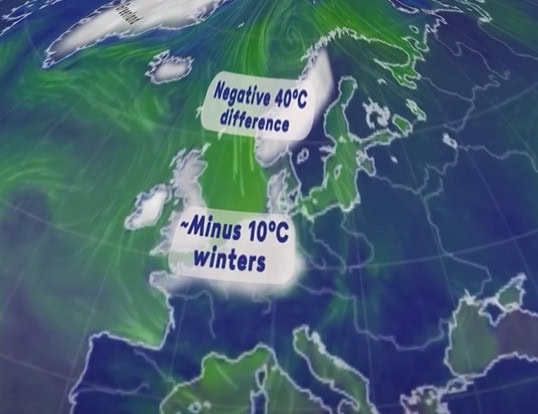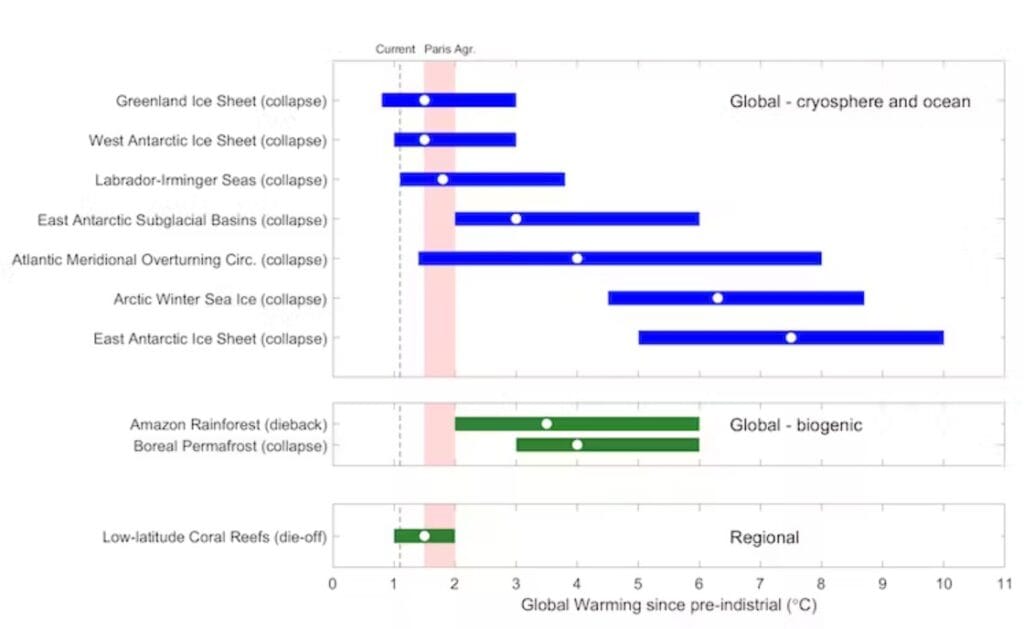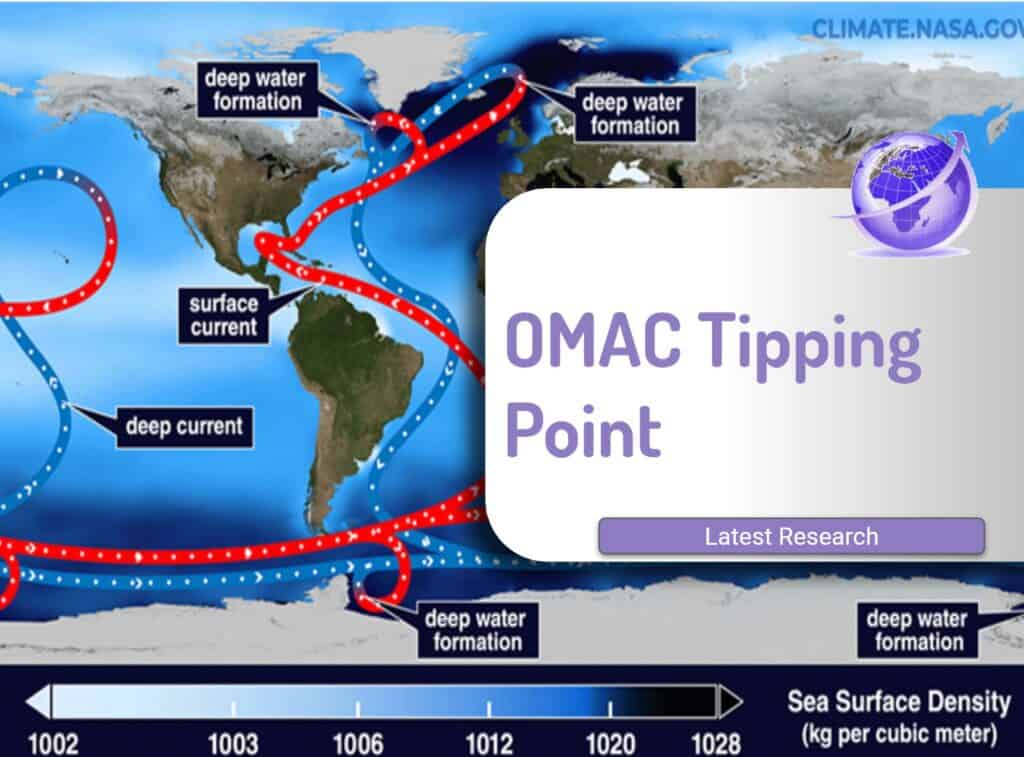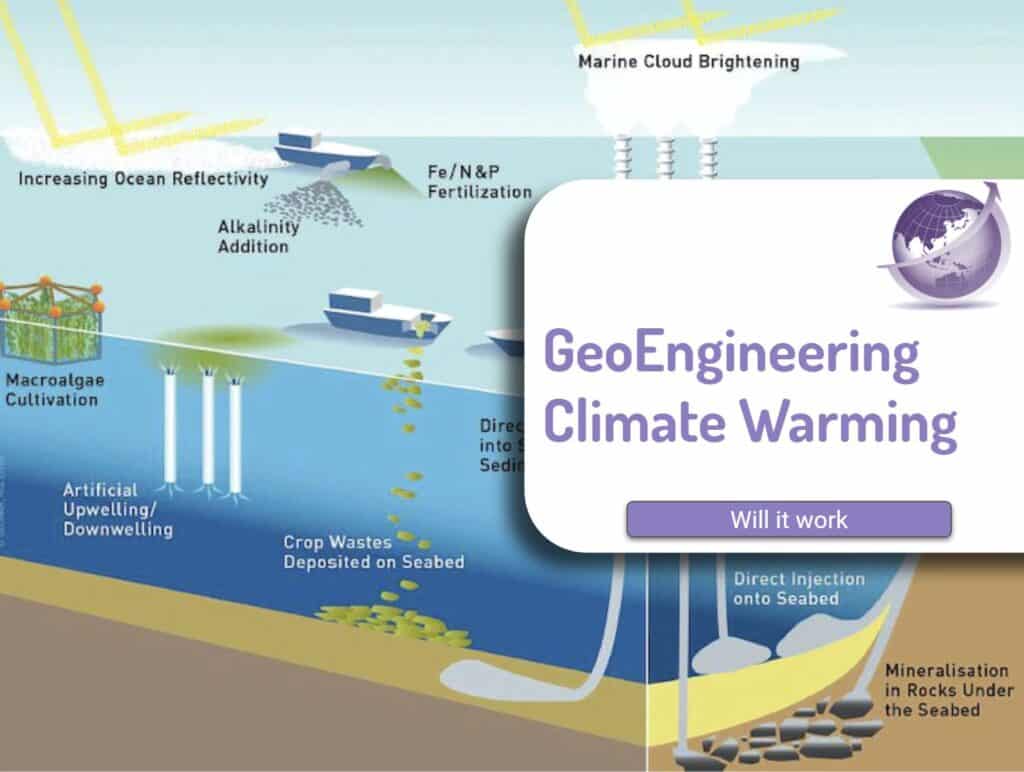Climate Change could introduce dire climate change and is the subject of the AMOC Tipping Point by René M. van Westen et al in a just published paper titled “Physics-based early warning signal shows that AMOC is on tipping course”. Another paper from Stefan Rahmstorf in April 2024 titled “Is the Atlantic Overturning Circulation Approaching a Tipping Point?” confirms the AMOC tipping point is probably sooner and more drastic than previously predicted.
- 7m sea rise
- Lower temperatures of at least 5° across Europe.
Leon Simons, Board member of the Club of Rome, on LinkedIn and his post on X.com details the tipping point. (Copied to enable easier reading.

What is AMOC & Latest Data
What is the Atlantic Meridional Overturning Circulation? (Previously known as the Atlantic conveyor belt.) Could it overturn? When could it overturn? What are the consequences?
That’s unclear but sooner than many suggested. Its northward flow of warm surface waters and deep cold return flow makes the South Atlantic a curiosity: it transports heat from the southern high latitudes toward the equator, from cold to warm. All other ocean basins behave “normally,” by moving excess heat away from the sun-soaked tropics.
AMOC has reversed in the past, and unclear if this could happen in 2024 or 2100. AMOC shutdown is not unusual and occurred in the Eemian (when the global temp was similar to today). Sea levels rose a few meters in the Eemian, within a century. The likely source was the collapse of the West Antarctic ice sheet.

As Simons says, it’s a shitload of water transporting a shit ton of heat energy North, through the Atlantic Ocean!
Not Just Impact on Northern Europe
Notice that the ice sheet comes down past Iceland, Ireland and UK. Rahmstorf points out the AMOC has major global climate repercussions even far from the Atlantic. They affected the tropical rainfall belts that result from the rising motion of warm air above the “thermal equator.” During warm events, rainfall belts shifted north, leading to warm and humid conditions in the northern tropics as far as Asia. But during other events, the rainfall belts shifted south, leading to catastrophic drought in the Afro-Asian monsoon region.

Physics of AMOC
The study starts with an AMOC strength of about 15 sverdrups, or 15 million cubic meters of ocean water per second. This transports about 1 PW (1 petawatt = 1*10^15 watt) of heat North from the Southern Hemisphere and the tropics.
That’s about 32 ZJ (32 zettajoules = 32*10^21 joules) of heat per year.

Greenland Melt On AMOC Impact
When the AMOC tips, most of this ocean heat transport stops. People are asking is “could this happen any time soon and how?” The study (as have others, for example @DrJamesEHansen et al. (2016) shows that a lot of fresh water input from rainfall and Greenland ice melt could shut this thing down this century.
The more fresh water is added, the slower the AMOC becomes. The tipping in the model happens at about 0.5 sverdrups (0.5 Sv, 0.5 million m³/s) of fresh water input.
There is a lot of fresh water waiting to add those 0.5 Sv, if only there was enough heat available to melt the ice sheet of Greenland. 0.5 Sv is 1.6*10^13 m³ of water per year.
Greenland holds 2.85*10^15 m³ of ice, which could provide about 170 years of 0.5 sverdrups of fresh water (after which global sea levels would be over 7 meters higher).

To melt 0.5 sverdrups worth of ice for a year takes 5.3 ZJ of heat.
How Much Energy Have Emissions Added
Since 1970, our greenhouse gases have caused about 450 ZJ of additional heat to accumulate in the Earth system. About 90% of that warmed the oceans. Aerosols, notably from coal plants and ships burning sulfur-rich fuels, have reduced that heat accumulation.
Now that we are reducing aerosols, more heat is accumulating. The larger North Atlantic Ocean region shows a spike in how much sunlight is being absorbed over recent years. Higher temperatures cause more heat radiation to space.
The net effect is a spike of over 2.4 W/m² above the 2000-2009 average. This spike added 4 ZJ of heat over 12-months:

The record high global energy imbalance is now (2023) about 1.8 W/m². This adds 29 ZJ of heat to the Earth system over a year.
To make a long story short, the heat is there to melt enough Greenland ice to shut the AMOC down.
And we don’t need all that heat to be directed to the melting of ice, as more precipitation also contributes. Bizarrely, we are only making the climate forcing and Earth’s Energy Imbalance worse by rapidly increasing greenhouse gas concentrations while decreasing aerosols.
Sorry I couldn’t make this more hopeful. But numbers don’t lie.
Leon Simons https://x.com/LeonSimons8/status/1757510473275084880?s=20
Sea Ice vs Land Ice Water Cycle
If all the extra heat since 1960 had gone to melting of land-ice, sea-levels would now be ~3 meters higher! That didn’t happen. The meltwater from the melting of glaciers and the Greenland and Antarctic ice sheet was largely compensated by the increased water cycle.

Other Tipping Points
For a good interactive view, check out this interactive from the NY Times “How Close Are the Planet’s Climate Tipping Points? Earth’s warming could trigger sweeping changes in the natural world that would be hard, if not impossible, to reverse.”


More Reading
- Extreme Climate Impacts From Collapse of a Key Atlantic Ocean Current Could be Worse Than Expected, a New Study Warns. (Inside Climate News https://insideclimatenews.org/news/09022024/climate-impacts-from-collapse-of-atlantic-meridional-overturning-current-could-be-worse-than-expected/
- Leon Simons: “Aerosol Demasking and Global Heating” | The Great Simplification #105 https://www.youtube.com/watch?v=RPAnoSt6FnY
- Ice melt, sea level rise and superstorms: evidence from paleoclimate data, climate modeling, and modern observations that 2 °C global warming could be dangerous. 2016 https://acp.copernicus.org/articles/16/3761/2016/
- René M. van Westen et al. ,Physics-based early warning signal shows that AMOC is on tipping course.Sci. Adv.10,eadk1189(2024).DOI:10.1126/sciadv.adk1189
- Dangerous climate tipping points will affect Australia. The risks are real and cannot be ignored UNSW Feb 2024 https://www.unsw.edu.au/news/2024/02/dangerous-climate-tipping-points-will-affect-australia–the-risk
- David I. Armstrong McKay et al. ,Exceeding 1.5°C global warming could trigger multiple climate tipping points.Science377,eabn7950(2022).DOI:10.1126/science.abn7950
- Is the Atlantic Overturning Circulation Approaching a Tipping Point? Stefan Rahmstorf 2024 https://tos.org/oceanography/article/is-the-atlantic-overturning-circulation-approaching-a-tipping-point
- How Close Are the Planet’s Climate Tipping Points? Earth’s warming could trigger sweeping changes in the natural world that would be hard, if not impossible, to reverse. https://www.nytimes.com/interactive/2024/08/11/climate/earth-warming-climate-tipping-points.html
- Atlantic overturning collapses in global warming projections after 2100 2024 : https://doi.org/10.21203/rs.3.rs-5077014/v1









